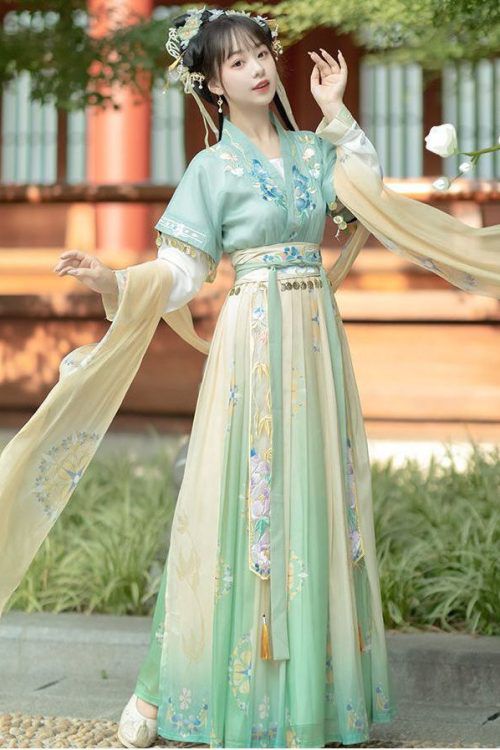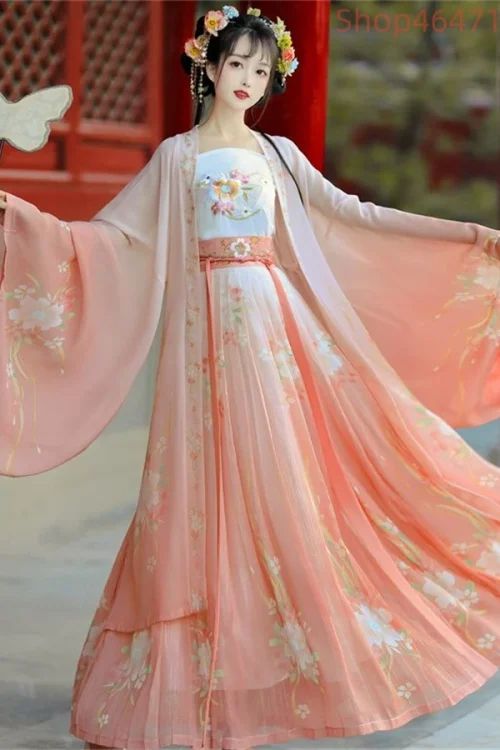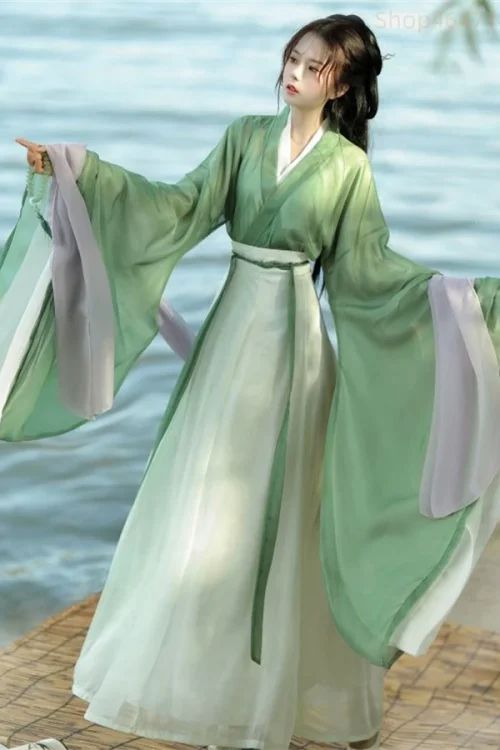Historical Significance and Cultural Heritage
In the realm of fashion, the allure of traditional garments like 汉服 transcends the boundaries of time. While modern attire often prioritizes comfort and practicality, Hanfu exudes an unparalleled elegance and cultural significance that sets it apart.
Hanfu, the traditional clothing of the Han Chinese, has a rich history spanning centuries. Its intricate designs, flowing silhouettes, and vibrant colors embody the aesthetic sensibilities of ancient China. The garments are meticulously crafted from high-quality fabrics, such as silk, cotton, and linen, ensuring both comfort and durability.

Beyond their aesthetic appeal, Hanfu holds immense cultural value. It represents the continuity of Chinese civilization and serves as a tangible link to the past. Each garment carries with it a story, reflecting the social hierarchy, customs, and beliefs of its time. By wearing Hanfu, individuals not only adorn themselves but also participate in the preservation of their cultural heritage.
In contrast, modern clothing often emphasizes functionality and mass production. While this approach may cater to the demands of fast-paced lifestyles, it can result in a loss of individuality and a homogenization of style. Hanfu, on the other hand, celebrates diversity and encourages self-expression. The wide variety of styles, colors, and patterns allows individuals to showcase their unique personalities and connect with their cultural roots.
Furthermore, Hanfu promotes a sense of community and belonging. By wearing traditional garments, individuals become part of a larger collective that values cultural preservation and appreciation. This shared experience fosters a sense of unity and pride, strengthening the bonds between members of the community.
In conclusion, the enduring appeal of traditional clothes like Hanfu lies in their timeless beauty, cultural significance, and ability to foster a sense of community. While modern clothing may offer convenience and practicality, it often lacks the depth and richness of traditional garments. By embracing Hanfu and other traditional attire, we not only enhance our personal style but also contribute to the preservation and celebration of our cultural heritage.
Aesthetic Appeal and Artistic Value
Traditional garments, such as the exquisite Hanfu, often captivate observers with their unparalleled aesthetic appeal and artistic value, surpassing the allure of contemporary attire. This superiority stems from several key factors that contribute to their enduring beauty and cultural significance.
Firstly, traditional garments are meticulously crafted with an emphasis on intricate details and exquisite embellishments. Hanfu, for instance, features elaborate embroidery, flowing sleeves, and delicate accessories that evoke a sense of elegance and refinement. These intricate details add depth and visual interest, creating a captivating spectacle that modern clothing often lacks.

Moreover, traditional garments are designed with a deep understanding of human form and movement. Hanfu, for example, is tailored to accentuate the wearer’s natural curves and grace, allowing for fluid and expressive gestures. This harmonious relationship between garment and body enhances the wearer’s presence and creates a visually pleasing silhouette.
Furthermore, traditional garments are imbued with cultural and historical significance. Hanfu, for instance, has been worn for centuries in China and carries a rich legacy of tradition and symbolism. The colors, patterns, and motifs used in Hanfu reflect the cultural values and beliefs of the time, providing a glimpse into the past and fostering a sense of connection to one’s heritage.
In contrast, modern clothing often prioritizes comfort and functionality over aesthetic appeal. While this approach may be practical for everyday wear, it can result in garments that lack the visual impact and artistic merit of traditional attire. Furthermore, modern clothing tends to follow fleeting fashion trends, leading to a constant cycle of disposable garments that contribute to environmental waste.
In conclusion, the aesthetic superiority of traditional garments like Hanfu lies in their intricate craftsmanship, harmonious design, and cultural significance. These factors combine to create garments that are not only visually stunning but also deeply meaningful, transcending the realm of mere clothing and becoming works of art that embody the beauty and heritage of a civilization.
Practicality and Comfort in Traditional Garments
In the realm of fashion, traditional garments like Hanfu have captivated the hearts of many with their timeless elegance and aesthetic appeal. While modern clothing often prioritizes practicality and comfort, traditional attire offers a unique blend of both qualities, surpassing the limitations of contemporary fashion.
Firstly, traditional garments are meticulously crafted with intricate details and exquisite fabrics. Hanfu, for instance, is renowned for its flowing sleeves, delicate embroidery, and vibrant colors. These intricate designs not only enhance the visual appeal but also provide a sense of cultural identity and heritage. In contrast, modern clothing often relies on mass production and synthetic materials, resulting in a lack of individuality and a diminished connection to tradition.

Moreover, traditional garments are designed with functionality in mind. Hanfu, for example, features loose-fitting robes that allow for freedom of movement and breathability. The wide sleeves provide ample ventilation, making it suitable for both warm and cold climates. Modern clothing, on the other hand, often prioritizes form over function, leading to garments that restrict movement or cause discomfort.
Furthermore, traditional garments are often made from natural materials such as silk, cotton, and linen. These fabrics are not only soft and comfortable against the skin but also possess inherent properties that regulate temperature and moisture. In contrast, modern clothing often incorporates synthetic materials that can be irritating to the skin and trap heat, leading to discomfort and health issues.
Additionally, traditional garments are often designed with a focus on modesty and propriety. Hanfu, for instance, covers the body from neck to ankle, adhering to traditional Chinese values of modesty and respect. Modern clothing, on the other hand, often emphasizes revealing or form-fitting designs, which may not be appropriate for all occasions or cultures.
In conclusion, traditional garments like Hanfu offer a superior blend of practicality, comfort, and aesthetic appeal compared to modern clothing. Their intricate designs, functional features, natural materials, and cultural significance make them a timeless choice that transcends the limitations of contemporary fashion. By embracing traditional garments, we not only enhance our personal style but also connect with our cultural heritage and promote a more sustainable and comfortable way of dressing.
